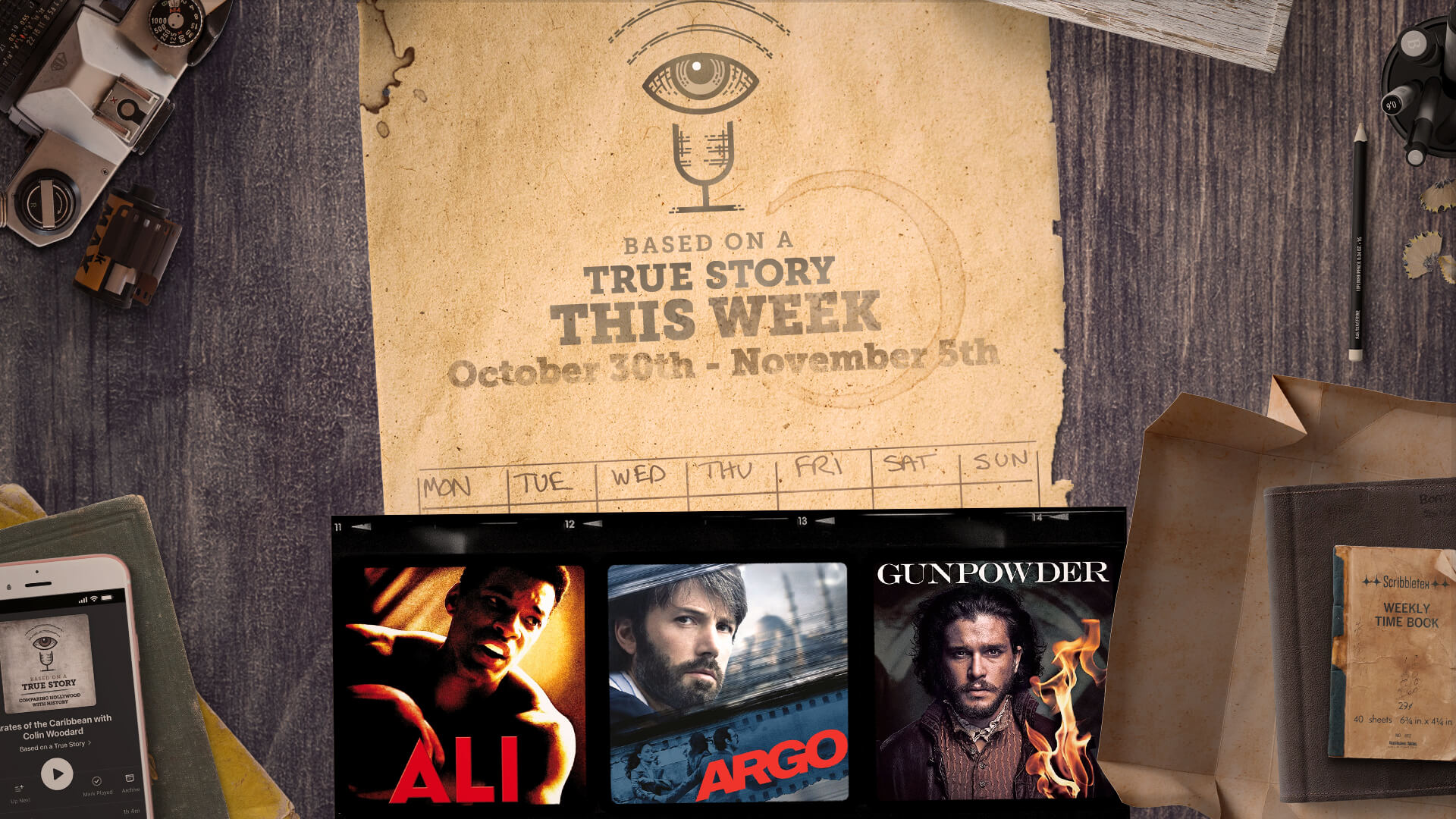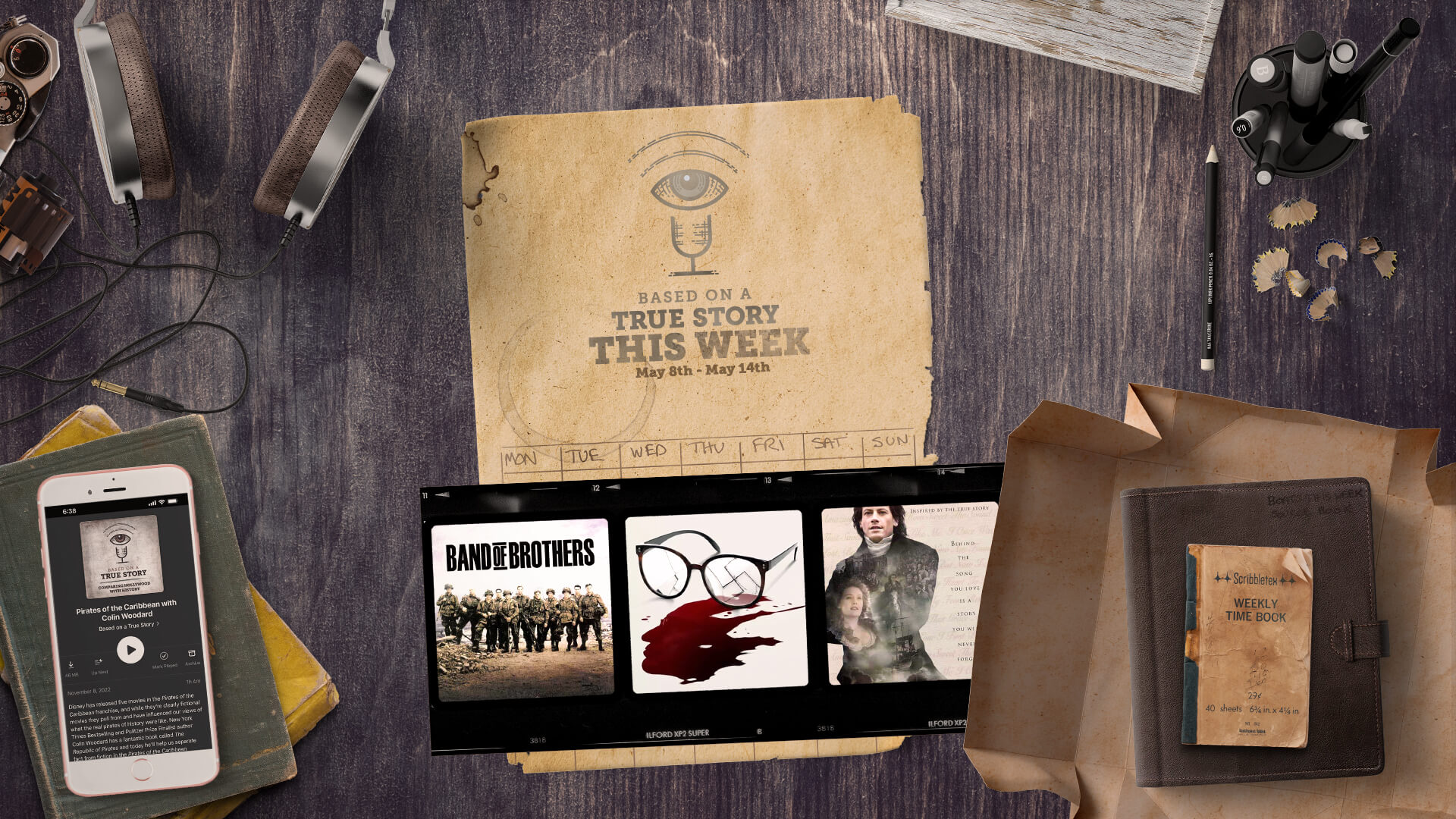In this episode, we’ll learn about historical events that happened this week in history as they were depicted in these movies: The Alamo, Selma, and Mary Queen of Scots.
Events from This Week in History
Birthdays from This Week in History
Movies Released This Week in History
- The Ordeal of Patty Hearst
- Honorable Mention: Nosferatu
Did you enjoy this episode? Help support the next one!
Disclaimer: Dan LeFebvre and/or Based on a True Story may earn commissions from qualifying purchases through our links on this page.
Transcript
Note: This transcript is automatically generated. There will be mistakes, so please don’t use them for quotes. It is provided for reference use to find things better in the audio.
March 6th, 1836. Texas.
It’s the early morning hours. So early that the sun hasn’t even started to peek over the horizon, leaving the screen nearly pitch black. We can hear some sounds of soldiers moving, although it’s hard to see them very well because it’s so dark.
We can see a soldier stab someone in the neck with a bayonet, making it so he can’t scream as he dies.
In the next shot we see Billy Bob Thornton’s version of Davy Crockett plucking at an instrument. Then, he seems to have heard something—maybe the noise of the man dying—but he doesn’t make any indication of what it was.
But, it was something.
Crockett stands up and looks over the wooden wall he was sitting right next to. On the other side he can see movement. Instantly, he ducks back down so he’s not seen. Then, without pausing, he stands back up and aims his rifle.
BANG!
All of a sudden, countless Mexican soldiers start yelling “Viva Santa Anna!” as they rush forward. Inside the walls, the noise has woken everyone up. Defenders take their places behind the walls and a huge battle ensues.
The true story behind this week’s event depicted in the movie The Alamo
This depiction comes from the 2004 movie called The Alamo. The event it’s showing in the segment that I described is something that happened this week in history: The final assault on the Alamo that ended the 13-day siege.
The true story is a little more difficult to give absolute facts about the smaller details like who fired the first shot, because the truth is that the final assault on the Alamo wasn’t very well documented. On top of that, everyone who was defending the Alamo died.
That’s not to say everyone died inside the Alamo, there were a few noncombatants—women and children, mostly—who survived. But, the death of the defenders makes it even more difficult to know exactly what happened in the hours and even days leading up to the final assault.
Was the famous Davy Crockett the first one to shoot early that morning like we see in the movie? We don’t know. But, realistically, it’s probably doubtful.
He did die there, though. But even his death is something we’re unsure of exactly how it happened. Some claimed to see his body among the other defenders while some say he was one of a few prisoners captured by General Santa Anna, and then he along with the other prisoners were executed after the battle ended.
What we do know is that there were 187 men who died at the Alamo and about 3,000 Mexicans involved in the final assault. When Santa Anna’s soldiers arrived there were about 5,000 men—1,544 of them died during the 13-day siege.
Davy Crockett was just one of 133 defenders from the United States who died at the Alamo. There were 41 from Europe and 13 native Texans.
When I say native Texans, that’s something important to keep in mind because this happened in 1836, and Texas wasn’t even a part of the United States at that time in history. In fact, it was in part because of what happened at the Alamo that helped Sam Houston end up winning the overall war because even though it was a defeat, it helped motivate Houston’s soldiers into forcing Santa Anna to concede Texas. Then, in 1845, the United States annexed Texas—which kicked off a new war between the United States and Mexico that started in April of 1846 and lasted until February of 1848.
If you want to watch the event that happened this week in history, though, check out the 2004 movie The Alamo. The final assault on the Alamo starts at an hour and 35 minutes into the movie.
And if you want to learn more about the true story, we covered that movie on episode #172 of Based on a True Story.
March 7th, 1965. Selma, Alabama.
There’s a line of people walking down the street. We can see they’re all dressed nicely as the camera pans up from polished shoes to suits for the men and nice dresses for the women.
We can hear a reporter’s voiceover, John Lavelle’s version of Roy Reed, explaining the scene as we see it unfold on screen.
About 525 Black men and women left Brown’s chapel and walked six blocks to cross Pettus Bridge and the Alabama River.
After a brief pause, Wendell Pierce’s version of Reverend Hosea Williams looks to Stephan James’ version of John Lewis standing alongside him at the front of the line of people. Lewis looks back at Williams. Then, after a subtle nod, they continue walking.
Everyone follows.
Reed continues to explain the event from a phone booth where we can assume he’s calling the newsroom back at the paper. He says they were young and old, carrying an assortment of packs, bed rolls and lunch sacks.
Then, we can see exactly that. Men and women of all ages carrying packs, bed rolls and lunch sacks as they walk across a street corner.
We can see a big bridge spanning a river. This must be the Pettus Bridge and the Alabama River that Reed mentioned earlier.
As the Black men and women cross the bridge, Reed’s voiceover picks back up again as he talks about troopers. Just then, we can see a line of police officers—all of them white—standing in a line. Reed explains the troopers were waiting 300 yards beyond the end of the bridge. There were the troopers, dozens of posse men, 15 of them on horses and at least 100 white spectators, many of whom are holding Confederate flags.
The Black men and women cross the bridge and approach the troopers.
Then, the camera cuts to David Oyelowo’s version of Dr. Martin Luther King, Jr. Someone calls and tells them to turn on the TV.
They turn on the TV just in time to see a special news bulletin.
The camera cuts back to the bridge where we can see the face-off between the troops and the people peacefully crossing the bridge. One of the troopers pulls out a megaphone and tells the crowd they have to disperse. The march will not continue.
Reverend Williams asks for a word with the Major in charge of the troopers. They refuse, there’s nothing to talk about. John Lewis asks again to speak with Major Cloud.
Michael Papajohn’s version of Major Cloud replies by giving a nod to the troopers, who all put on gas masks. Then, he orders them to advance and the troopers rush the crowd.
What follows is mayhem. Troopers beating innocent men and women in what ends up being a scene mixed with tear gas and blood.
The true story behind this week’s event depicted in the movie Selma
This comes from the 2014 movie called Selma. The event it’s depicting in the segment that I described is something we now know as Bloody Sunday, which took place this week in history on March 7th, 1965.
While the movie’s portrayal is well done from a historical perspective, there is more to the story.
There were 300 protesters who started from Brown Chapel in Selma, Alabama at 3 PM on Sunday, March 7th, 1965. The reason why so many of the protesters were carrying lunch packs, sleeping bags and things like that was because the original plan was to march the 54 miles from Selma to Montgomery. That’s the capital of Alabama, and once there the protesters planned to hold a rally on the steps of the state capitol.
But they never made it the 54 miles—instead, they made it a little over a mile to the Edmund Pettus Bridge that spans the Alabama River.
That’s where, just like we see in the movie, a bunch of Alabama State Troopers along with some vigilantes who were all under the command of Major John Cloud blocked the way. And just like we see in the movie, Major Cloud refused to speak to the protestors and, after ordering them to disperse, ordered gas thrown into the crowd. Then, they used force—clubs and other weapons to beat the protestors until they all fled back to Selma.
While the event wasn’t broadcast live like the movie makes it seem, it was filmed and broadcast later—the images from Bloody Sunday were etched into history and helped in the campaign for passing the Voting Rights Act of 1965.
If you want to watch the event that happened this week in history, check out the 2014 movie called Selma, the march across the bridge happens at about an hour and 10 minutes into the movie.
And if you want to learn more about the true story, we covered that movie on episode #167 of Based on a True Story.
March 9th, 1566. Edinburgh, Scotland.
We’re inside a stone room, and there are four people seated at a round table. Each of the three women at the table are dressed in dark—maybe they’re black dresses, but the room is dimly lit by the fireplace just off the camera so it’s hard to tell for sure. What we can tell is their dark dresses are a contrast to the one man at the table, who is wearing what looks like a white tunic. All four of them are laughing and enjoying each other’s company as they’re playing a game of cards.
The camera cuts to a stone staircase. We can see men’s boots climbing the stairs. Then, another cut, and we can see a series of three or four men climbing inside a dark room. This, too, is dimly lit by the fire—not a fireplace this time, but there’s one torch at the top of the staircase and maybe another just off camera to cast a little more light on the stairs themselves.
The sound of the approaching footsteps alerts the presence of the advancing men to another man wearing armor. He watches as they approach, and now we can see what looks like at least six men who came up the staircase and are walking in a very determined manner.
With a camera cut, now we’re inside the room where the game of cards was being played around the table. We can see the fireplace burning off to the side as the six men burst through the door.
The laughter from the four around the table stop as they stand up. One of the women, who we can better see now is Saoirse Ronan’s version of Mary Stuart, confronts the men.
“You dare charge into my chamber unannounced?” She demands of them.
Now we can see there are certainly more than six men. One of them calls out the name of the man in the white tunic: “David Rizzio!”
The other two women stand in front of David, blocking him from being taken away. Mary herself is too far away, but she reminds the men who burst into the room that she is with child as they usher her away from David and into the arms of another man, Jack Lowden’s character, Henry Darnley. As he hands Mary over to Henry, the man tells her that this is all being done in Lord Darnley’s name.
From across the room, David Rizzio screams out as he tries to escape the men holding him back.
Mary starts hitting at Henry, demanding he tell her what he’s done.
Henry holds her hands, telling her simply that it is done. Do not interfere.
David Rizzio is tossed to the ground by one of the men who was trying to stop him from escaping. Mary squirms out from Henry’s grasp and rushes to David on the ground, helping him up. David accepts the help, then once he’s up, he holds onto Mary—using her as a human shield. She’s not fighting it, though, and it almost seems as if she’s allowing herself to be placed between David and the assailants in the room.
They stand at odds for a moment until, from behind, another man walks up and stabs David in the back as he yells out “Adulterer!”
David screams in pain as Mary just screams. Then, another man steps up behind David and stabs him again. With a knife to Mary’s belly, one of the men orders her to stand aside. The sound of crying can be heard in the room as the other women who were in the room sob uncontrollably. David begs Mary not to leave him, and she cries as she separates herself from him. Then, once she’s away from him, some of the men grab David forcefully and form a circle around him where they proceed to stab him over and over.
The true story behind this week’s event depicted in the movie Mary Queen of Scots
This comes from the 2018 movie called Mary Queen of Scots. The event that I described is the movie’s depiction of the murder of David Rizzio, which happened this week March 9th, 1566, at the Palace of Holyroodhouse. It happened at about 8:00 PM, to be precise, in the Queen’s supper chamber—a room that still exists in the palace to this day.
This is one of those events that we simply don’t know exactly what happened because it’s not really one of those events that gets documented. It was, after all, a murder.
But, with that caveat in mind, the movie’s portrayal isn’t a bad one for what we do know of the true story.
David Rizzio was Mary, Queen of Scots’ private secretary. As such, he was a good friend of hers and so the scene we see in the movie with him being the only guy with Mary and other women might’ve been a common scenario. That friendship was something Mary’s husband didn’t like. That’d be Lord Henry Darnley, the guy who we see telling Mary not to interfere.
Something else we saw in the movie was the first person to stab David Rizzio calling him an adulterer. That’s also true, but again it’s something that we don’t know if it’s really true.
Haha! Okay that can be confusing.
What I mean is that it is true that some people thought David Rizzio was having an affair with the Queen. One of those people who thought that, as you can probably guess, was Lord Darnley. And there were plenty of other rumors. For example, in the movie we hear Mary talking about being pregnant—that is true! And some of the rumors at the time suggested it was David Rizzio’s child.
But the part we don’t know for certain is whether or not David Rizzio actually was having an affair with Mary. It was debated then, and it’s been debated ever since.
Something else we see happening in the movie that some who were there claimed to have happened was when David Rizzio hid behind Mary. He did that after they burst into the room led by a man named Lord Patrick Ruthven. He’s not a character in the movie, but I’m pointing him out because he showcases how there are multiple sides to the story.
After they burst into the room and demanded David Rizzio be handed over, just like we see in the movie, Mary refused. That’s when David hid behind her for protection, probably knowing they’d be less likely to attack the Queen. In the movie, we see someone pointing a knife at Mary’s belly to force her to separate from David. And it is true that Mary claimed that’s what happened. But, Lord Ruthven’s version of the story differed. He said that didn’t happen.
What did happen, though, was that once David was separated from Mary, it was all over for him. He was stabbed 57 times—although, again, that number has been in question. But, it was a lot.
If you want to watch the event that happened this week in history as it’s portrayed in the movies, check out the 2018 movie Mary Queen of Scots. We started our segment today at about an hour and nine minutes into the movie.
Share this:
- Click to share on Twitter (Opens in new window)
- Click to share on Facebook (Opens in new window)
- Click to share on Reddit (Opens in new window)
- Click to share on Pocket (Opens in new window)
- Click to share on LinkedIn (Opens in new window)
- Click to share on WhatsApp (Opens in new window)
- Click to share on Telegram (Opens in new window)
- Click to email a link to a friend (Opens in new window)
- Click to print (Opens in new window)



